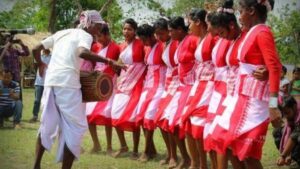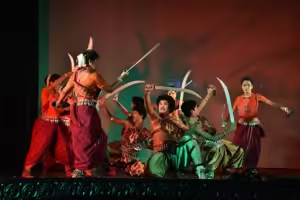Currently Empty: ₹0.00
Drama & Theatre
Theatre of Jharkhand: Tribal Tradition and Art

Theatre of Jharkhand
Jharkhand, being a land of breathtakingly beautiful natural and equally rich tribal heritage, commands special cultural status essentially on account of its natives. This miniature piece of earth that constitutes the state has succeeded in preserving great potentiality in carrying the cultural legacy through its theatre traditions, which are integrally related to customs, folk tales, and rituals of its tribals. Jharkhand theatre is an amalgamation of folk performances, tribal stories, and urban modernist theatre practices in portraying its social, political, and cultural realities.
The present blog discusses both traditional and modern theatre in Jharkhand, with a special focus on tribal theatre as a binding force, the folk tradition, the emergence of modern theatre, and some of the personalities that have shaped this journey of theatre development in the state.
Historical Context of Jharkhand Theater
Theater in Jharkhand has been carved deeply, just like the state itself, with tribals being its prime founders. The state hosts a lot of indigenous groups such as Santhals, Mundas, Oraons, and Hos; each has a well-defined tradition of storytelling. Centuries have seen these communities take the help of theater to communicate stories on creation, nature, life, and death, along with the values that regulate their respective societies.

The pre-colonial Jharkhand theatre was symbolically related to rituals, festivals, and congregations. It was enacted in the open air, either at a village square or in front of sacred groves. Theatre made very few uses of props or costumes. Music, dance, and mime were integral parts of many times dealing with nature, spirits, and gods.
And slowly, as large the engagement of Jharkhand became with the world outside, especially in the colonial period and its expansion and later in the post-independence period, so did theatre take up modern forms and narratives. Today, the theatre of Jharkhand depicts a frame of its tribal past and its modern aspirations, with coming of age to contemporary social issues, yet holding on to its root.
Tribal Traditions of Theatre in Jharkhand
Theatre in Jharkhand is rooted in the tribal theatre of the state. Their performances relate to their rituals, festivals, and other social customs with a motive to make future generations aware of oral history, cultural values, and knowledge. Although every tribe has its specific traditions of theatre, some common characteristics lie in characterizing Jharkhand tribal theatre.
- Jhumur: The Musical Folk Theatre
Among all, jhumur is the most well-known folk theatre that prevails in the Jharkhand State and is especially associated with the Santhal, Oraon, and Munda people. Though a folk dance form, it relates to theatre expression by telling stories, dialogues, and even mimes.

Key features of Jhumur:
Musical and Dance Aspects: Jhumur can be defined as a rhythmic act infused with music and dance. The traditional instruments of performance include dhol, madal, and kartal which add a hyperactive yet melodious ambiance to the show. Usually attired in bright tribal costumes, performers dance around in circle-skipping fashion while singers and chanters take turns.
The narration of Jhumur essentially consists of this dancing form, but it narrates themes related to nature, seasons, and the daily livelihoods of the tribals. The themes projected most probably are those of love, agriculture, harvest, and social customs.
Community Participation: The Jhumur is sung at fairs and social ceremonies; hence, it seeks community participation. It is a participation en masse where performers and audiences merge into one in the event of a performance.
Jhumur, hence, becomes a way of bringing social bonding where the whole community comes together as one and rejoices in their heritage.
- Chhau: The Martial Arts Theater
It is a kind of dance theatre originating from the tribal regions of Jharkhand, West Bengal, and Odisha. The most important is Seraikela Chhau in Jharkhand, the martial aspect of which has predominated in dramatic enactment.

Salient Features of Chhau:
Mythological themes: In every performance of Chhau, there is some reference to Hindu mythology, either as an episode from the Mahabharata or the Ramayana. The stories of gods and demons enacting epic battles are depicted through dance, mime, and martial arts movements.
Masks and Costumes It would be superfluous to mention that the characters of the Seraikela Chhau performance don masks. Every character wears an elaborately designed, brightly colored mask representing his role as a god, demon, or hero. Costumes, too, are bright in color and symbolic. End.
The performance of Chhau is immensely physical, and hence a huge part of the choreography includes acrobatic movements and martial arts techniques. Artists trace battles and other action scenes, complete with leaps, spins, and jumps, loading the performance with intense dynamic energy.
Chhau is a mode of aesthetic expression, and also an instrument of spiritual- cum-physical training of the artists who undergo grueling training to attain the perfection of its intricate movement.
- Paika: The Warrior Dance Theatre
Another style of dance theatre in Jharkhand is Paika, and this also has its roots in the warrior tradition of the state. The dance is performed by the community called the Paikas, who traditionally come as warriors and guards to the tribal kings. The dance in itself depicts their martial prowess and valor.

Key Features of Paika
Warrior Themes: Bravery, valor, and war are the usual themes inspiration for most performances in Paika. Dancers dress up as warriors and go through some re-enactments of battles, with or without accessories like swords and shields. Performance is fast and heavy, with the inertia of martiality carried over from the dance.
Physicality and Strength: This dance is like Chhau in itself; it’s largely physical. The Paika dancers perform strong and flexible movements by robust leaps and bounds, going to sham combats. This is also a celebration of physical strength and war skills.
Social and Ritual Significance: It is done during festivals and other major social events like weddings and harvests. The dance is not sheer entertainment but rather a ritual engagement that carries deep spiritual and cultural value for the community of Paikas.
Modern Theatre of Jharkhand
The base of Jharkhand theatre is tribal traditions, but it took a modern theatrical shape mostly in the cities of Ranchi and Jamshedpur. Modern Jharkhand theatre has been drawing upon the rich cultural heritage along with contemporary social issues to result in a judicious blend of tradition and modernity.
- Establishment of Modern Theatre Group
Different theatre groups of Jharkhand have been playing a great role in the promotion of modern theatre, and at the same time, they place some important social problems before the public through their performances. Among such theater groups, the most important one is Rangashree Natya Sansthan of Ranchi. This group was formed by a group of theater activists and had always been upfront on issues like staging current plays centered on poverty, corruption, displacement, and ecological imbalances.
Another very active theatre forum is the Jamshedpur Theatre Association, which has been promoting Hindi and regional language theatre with great vigor. The JTA takes it upon itself to conduct annual theatre festivals, workshops, and plays that provide local playwrights, directors, and actors a platform to showcase their works.
- Themes in Contemporary Theatre
Modern theatre in Jharkhand often concerns itself with issues related to the state’s unique socio-economic and political context. Some of the pertinent themes are:
Tribal Identity and Rights: Most of the contemporary plays underline the agony faced by the tribal population of Jharkhand due to modernization, industrialization, and displacement regarding land. The plots are based on land rights, tribal identity, and exploitation related to the environment.
Social Inequality: Most of the plays of the modern theatre movement in Jharkhand address issues of social inequality regarding caste, class, and gender. Shows have beheld these brutal realities of deprived communities living together in the fight for justice and dignity. Theatres dealing with political issues of corruption, exploitation, and failure of governance to work are yet another popular trend for political themes in the Jharkhandi theatre. Hence, performances turned into mediums for social commentary to create an awareness for change. 3. Theatre Festivals: Their Role Theatre festivals are strong platforms for the promotion and development of modern theatres coming up in the state of Jharkhand. In that aspect, the Ranchi Theatre Festival, held yearly, gets together not only in the state but also in national theaters. The event is a big platform that offers ample opportunities to the traditional and modern theatres through various ranges of performances depicted through the cultural diversity of Jharkhand. Events like the Jharkhand Tribal Theatre are pretty much committed to spreading the margins of tribal performance traditions so that the performance forms by autochthons in the state are not lost. Influence of Great Personalities Theatrical key figures have shaped both the traditional and modern times in Jharkhand. Therefore, among the important people of theatre in Ranchi, the name Sambhu Mitra features a great playwright and director who has been at the forefront of promoting modern Hindi theatre in the state. His plays most often interact at the intersection of tradition and modernity to bring out the challenges faced by the tribal and rural communities of the state in socio-political terms. Gladson Dungdung was a tribal rights activist and also a playwright who contributed a lot to Jharkhandi theatre with plays about the tribals’ plight regarding land displacement and industrialization. His works have been the strong voices of the voiceless, demanding justice and equality. Jharkhand theatre is a tapestry oozing with rich traditional tribal art, folk presentations, and modern expressions. From the rhythmic dance of Jhum




